Our processes include various coating methods from the gas phase (plasma processes, PVD, CVD processes) and liquid phase (dipping, blade coating, spraying, spin coating) – from laboratory to pilot scale.
Process and system development
The many issues for which coating processes are developed at Fraunhofer IGB are not limited to small laboratory systems. Thanks to the good instrumental equipment, scaling concepts such as continuous treatment of fiber and roll goods can also be implemented.
Offer from process to sample coating
For all coatings we offer the development of a complete process - from the coating, process development and scaling up to the sample coating. We will be pleased to make you an individual offer.
 Fraunhofer Institute for Interfacial Engineering and Biotechnology IGB
Fraunhofer Institute for Interfacial Engineering and Biotechnology IGB

